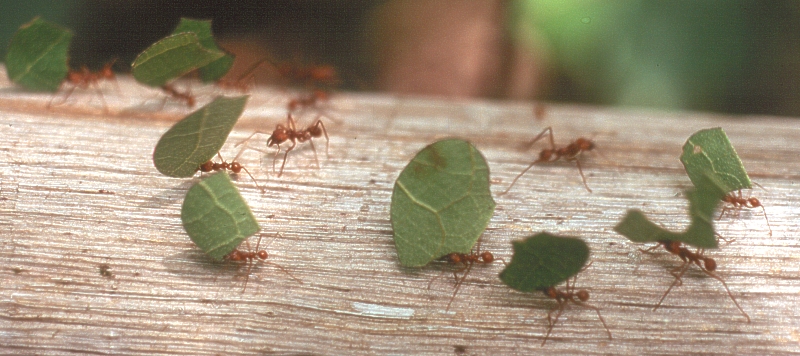Home >> Where fungi grow >> Mutualists >> Mutualisms with animals
MUTUALISMS BETWEEN FUNGI AND ANIMALS
There are more species of animals than any other group of organisms, so it is not surprising that fungi have come to form mutualistic relationships with many of them. These relationships are varied and involve several groups of animals. Even humans know the value of teaming up with fungi, and have done so for the making of bread, alcohol, antibiotics and many other products.
We focus here on two broad areas; the growing of fungi by animals as a source of food, and on the more intimate area of gut mutualisms. Both of these mutualisms involve familiar animals and both are highly developed relationships.
Animals cultivating fungi as food

The picture above shows a group of ants, aptly called leaf-cutting ants. These particular individuals were part of a group that had been out foraging in a Costa Rican tree in search of suitable leaves to be cut up and transported. You may have noticed that all of the ants carrying leaves are headed in the same direction, while another without a leaf is going against the traffic. One ant seems undecided; perhaps she dropped her leaf but, judging from her large head and jaws, she is more likely a soldier serving guard on the group. The ones carrying leaves are headed back to their colony where the leaves will be carefully inspected. Unsuitable leaves will be thrown out of the nest and the rest will be chewed up into a paste. The leaf paste is then added to a mass of previously chewed leaves. This mass is usually more or less spherical and may range in diameter from about a centimeter to the size of a tennis ball. The mycological interest lies in the fact that at the time the ball was formed the ants introduced a fungus to its surface and allowed it to grow. Eggs were then laid on the "garden" by the queen and the larvae hatching from these eggs fed exclusively on the fungus.
So why would these ants bother to cut leaves, carry them home, chew them up and inoculate them with a fungus when they could just as well eat the leaves themselves? The answer to this is not entirely clear, but this phenomenon may be related to the behaviour of other animals that eat dead plant debris and who purposely select pieces that have been colonized by fungal hyphae. It has been shown in experimental studies that fly larvae that eat leaf debris gain more weight if their food contains fungi than if it does not. Possibly fungal protein is more digestible by animals than plant protein. Many, if not most, leaves contain toxins that discourage animals from eating them. It has been suggested that fungi growing on fallen leaves detoxify them and leave them safe to eat. Perhaps the leaf-cutting ants are using the fungus for this purpose.
Leaf-cutting ants are not the only animals to cultivate fungi. Certain groups of mound-building termites do exactly the same thing, using fungi related to those used by ants. A group of beetles called "ambosia beetles" burrow into the wood of freshly-fallen trees where they create extensive systems of tunnels. The beetles inoculate these with a specific fungus, the ambrosia, that they carry in special pockets called mycangia. They then lay eggs in the tunnels and the developing larvae feed exclusively on the ambrosia. Certain wood wasps do a similar thing.
Gut mutualisms

The moose in this picture seem much too large to have any interest in fungi, but looks are deceiving. Moose are ruminants; that is, their digestive systems contain several large chambers that help them to deal efficiently with the mass of plant material they consume. This system of chambers contains the animal's food in a semi-liquid state in surprisingly large quantities. A large cow, not really any bigger than a moose, may have as much as 160 liters of food material in these chambers at one time. The rumen, the largest of the chambers, is in reality just a big fermentation tank. It contains, along with the semi-fluid suspension of chewed plant material, a mixture of microorganisms that are able to convert the otherwise indigestable cellulose of the plant material to a form the moose can use. Many microorganisms are involved in rumen mutualisms, including bacteria and certain "protozoa". Another important part of this microbial community is a group of fungi called chytrids (see the section on the Chytridiomycota for a closer look at this group), especially members of the genus Spizellomyces.
Dispersal mutualisms
Many fungi take advantage of the mobility of animals to carry their spores long distances. In some cases the animal is lured in by a reward such as a sweet substance. If so, a simple type of spore transport moves into the realm of mutualism.